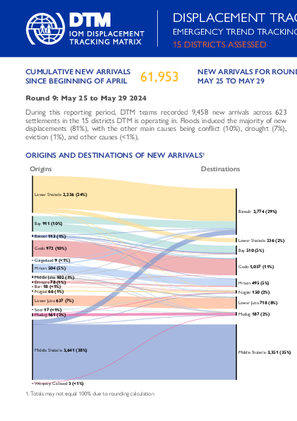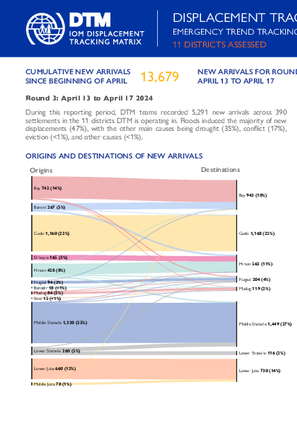-
Countries
-
Data and Analysis
-
Special Focus
-
Crisis Responses

Contact
DTM Burundi, DTMBurundi@iom.int
Language
French
Location
Burundi
Period Covered
Jul 01 2023
Dec 31 2023
Activity
- Survey
- Displacement Solutions
The Stability Index comprises data collected through interviews with key informants at local level (lowest possible administrative level) in target provinces affected by internal displacement and return movements of Burundian refugees from neighbouring countries. Key informants, including IDP and returnee representatives, community agents and Red Cross volunteers, were interviewed at each location by investigators in January 2024.
The use of key informants has the advantage of enabling wide geographical coverage. Several key informants were interviewed in each hill side, enabling IOM to triangulate in order to validate this information. In total, the 363 places of return and/or displacement assessed in the first (December 2022) and second (June 2023) rounds were also assessed in the third round in the same provinces of Cankuzo, Cibitoke, Kirundo, Makamba, Muyinga, Rumonge, Rutana and Ruyigi, to enable the observation of changes over time. Using the results of the DTM baseline assessments and the mapping of returnees provided by the United Nations High Commissioner for Refugees (UNHCR), hills were selected to identify areas with large numbers of displaced people and returnees. The recurrence of environmental hazards due to climate change and the large number of returnees were key factors in the choice of hills .

Contact
DTM Pakistan, DTMPakistan@iom.int
Language
English
Location
Pakistan
Period Covered
May 16 2024
May 31 2024
Activity
- Flow Monitoring
The International Organization for Migration (IOM) in Pakistan collects data on the outflows of Afghans at the Torkham (Khyber Pakhtunkhwa), Badini, Bahramcha and Chaman (Balochistan) border crossing points (BCPs) to better understand the movements of Afghans returning to Afghanistan. The data presented below is harmonised with those from the United Nations High Commissioner for Refugees (UNHCR), who also cover Ghulam Khan (Khyber Pakhtunkhwa).
On 26 September 2023, the Ministry of Interior in Pakistan announced its decision to enact its “Illegal Foreigners’ Repatriation Plan (IFRP)”. Between 16 and 31 May 2024, 21,259 Afghan nationals returned to Afghanistan, including 14,464 through the Torkham BCP, 5,914 through the Chaman BCP, 881 through the Ghulam Khan BCP, while no Afghan nationals returned through the Badini and Bahramcha BCPs. In addition, border authorities deported 562 individuals due to a lack of valid documentation. Since 1 January 2024, IOM identified 118,518 returns at the four BCPs.

Contact
DTM Europe, DTMMediterranean@iom.int
Language
English
Location
Republic of Moldova
Period Covered
Jan 01 2024
Mar 31 2024
Activity
- Survey
- Flow Monitoring
The IOM’s Displacement Tracking Matrix collected data through Surveys with Refugees in the Ukraine Response region from January to March 2024. In the Republic of Moldova, a total of 1,507 surveys were collected. This report focuses on the economic integration of the respondents, delving deeper into their employment profiles, skills, and prospects for participation in the local labour market.
Key findings:
- 82% of the respondents possessed Temporary Protection Status. Others reported having: irregular status (13%), refugee status (2%), or residence permits (3%).
- 87% of the active respondents were employed in Ukraine before displacement. After being displaced in the Republic of Moldova employment rates were 49% among the respondents that actively participated in the labour market.
- Among employed respondents, 37% had an official working contract in the Republic of Moldova and 30% were working based on a verbal agreement. The remaining 33% had a remote working contract in another country.
- Two-thirds (66%) of men and 47% of women were satisfied with their working arrangement.
- Respondents reported an average monthly expenditure of 285 euro on rent and 110 on utilities.
- 44% of the surveyed households had a total monthly income of less than 400 euros.
- 65% reported receiving an average of 300 euros monthly in remittances from Ukraine.

Contact
DTM Europe, DTMMediterranean@iom.int
Language
English
Location
Serbia
Period Covered
Apr 01 2024
Apr 30 2024
Activity
- Survey
- Flow Monitoring
This report provides insights into the profiles, experiences and journeys of migrants transiting through the Republic of Serbia. Data was collected from 1 to 30 April 2024 together with the Commissariat for Refugees and Migrants of the Republic of Serbia (SCRM). The sample consists of 147 interviewed migrants in Asylum Centres (AC) Sjenica, (AC) Tutin, (AC) Krnjaca, (AC) Obrenovac, and Reception Centres (RC) Bujanovac, (RC) Presevo, (RC) Dimitrovgrad across the country.

Contact
DTM Nigeria, iomnigeriadtm@iom.int
Language
English
Location
Nigeria
Period Covered
May 20 2024
May 26 2024
Activity
- Mobility Tracking
- Event Tracking
Between 20 and 26 May 2024, a total of 1,305 new arrivals were recorded at locations in Adamawa and Borno states. The new arrivals were recorded at locations in Askira/Uba, Bama, Gubio, Gwoza, Kaga, Kala Balge, Monguno and Ngala Local Government Areas (LGAs) of the most conflict-affected Borno State and in Fufore, Gombi, Guyuk, Hong, Lamurde, Madagali, Maiha, Michika, Yola North and Yola South LGAs of Adamawa State.
ETT assessments identified the following movement triggers: military operations (306 individuals or 23%), poor living conditions (275 individuals or 21%), fear of attack (245 individuals or 19%), seasonal farming (243 individuals or 19%) improved security (150 individuals or
11%) and family re-unification (86 individuals or 7%).

Contact
DTM Nigeria, iomnigeriadtm@iom.int
Language
English
Location
Nigeria
Period Covered
May 13 2024
May 19 2024
Activity
- Mobility Tracking
- Event Tracking
Between 13 and 19 May 2024, a total of 870 new arrivals were recorded at locations in Adamawa and Borno states. The new arrivals were recorded at locations in Askira/Uba, Bama, Gubio, Gwoza, Hawul, Jere, and Kaga Local Government Areas (LGAs) of the most conflict-affected Borno State and in Gombi, Hong, Madagali, Michika, Mubi South, Song, Yola North and Yola South LGAs of Adamawa State.
ETT assessments identified the following movement triggers: improved security (276 individuals or 32%), seasonal farming (154 individuals or 18%), military operations (143 individuals or 16%), poor living conditions (126 individuals or 14%), family re-unification (102 individuals or 12%), fear of attack (44 individuals or 5%) and attack (25 individuals or 3%).

Contact
DTM Somalia, IOMSomaliaDTM@iom.int
Language
English
Location
Somalia
Period Covered
May 25 2024
May 29 2024
Activity
- Mobility Tracking
- Baseline Assessment
This latest round of Emergency Trends Tracking was initiated in April 2024 to monitor displacements movements during the Gu rainy season. Districts covered in this round include Afgooye, Afmadow, Baardheere, Baidoa, Balcad, Belet Weyne, Dayniile, Gaalkacyo, Garoowe, Hodan, Jamaame, Jowhar, Kahda, Kismaayo, Luuq.
ETT is a crisis-based tool that tracks sudden displacement triggered by specific events or emerging crises. The objective of ETT is to help prioritize humanitarian response and to enable partners to deliver rapid assistance. Based on previous shock induced displacement patterns, the humanitarian community expects that people will continue to move toward urban areas in search of humanitarian services. Consequently, the ETT coverage focuses on the main urban centers and surrounding villages for each assessed district. The data is collected through Key Informant Interviews (KIIs) at the location level, from Sunday to Wednesday every week. It includes information on new arrivals, numbers and demographic of IDPs, reasons for displacement, intentions, humanitarian assistance and priority needs among others.
The ETT tool also adapts to regional contexts: because of the very high number of IDP sites in Khada and Daynile districts in Banadir region and in Baidoa district in Bay region, a zonal approach has been adopted for these areas. Each week, KIIs are first conducted at the zone level to indicate to the field teams which locations have received the most new arrivals and which need to be assessed. To facilitate the joint analysis of the CCCM (Camp Coordination and Camp Management) Cluster’s New Arrivals Tracker (NAT) and ETT data, the assistance and needs indicators are identical in both tools.

Contact
DTM Somalia, IOMSomaliaDTM@iom.int
Language
English
Location
Somalia
Period Covered
May 04 2024
May 08 2024
Activity
- Mobility Tracking
- Baseline Assessment
This latest round of Emergency Trends Tracking was initiated in April 2024 to monitor displacements movements during the Gu rainy season. Districts covered in this round include Afgooye, Afmadow, Baardheere, Baidoa, Balcad, Belet Weyne, Dayniile, Gaalkacyo, Garoowe, Hodan, Jamaame, Jowhar, Kahda, Kismaayo, Luuq.
ETT is a crisis-based tool that tracks sudden displacement triggered by specific events or emerging crises. The objective of ETT is to help prioritize humanitarian response and to enable partners to deliver rapid assistance. Based on previous shock induced displacement patterns, the humanitarian community expects that people will continue to move toward urban areas in search of humanitarian services. Consequently, the ETT coverage focuses on the main urban centers and surrounding villages for each assessed district. The data is collected through Key Informant Interviews (KIIs) at the location level, from Sunday to Wednesday every week. It includes information on new arrivals, numbers and demographic of IDPs, reasons for displacement, intentions, humanitarian assistance and priority needs among others.
The ETT tool also adapts to regional contexts: because of the very high number of IDP sites in Khada and Daynile districts in Banadir region and in Baidoa district in Bay region, a zonal approach has been adopted for these areas. Each week, KIIs are first conducted at the zone level to indicate to the field teams which locations have received the most new arrivals and which need to be assessed. To facilitate the joint analysis of the CCCM (Camp Coordination and Camp Management) Cluster’s New Arrivals Tracker (NAT) and ETT data, the assistance and needs indicators are identical in both tools.

Contact
DTM Somalia, IOMSomaliaDTM@iom.int
Language
English
Location
Somalia
Period Covered
Apr 27 2024
May 01 2024
Activity
- Mobility Tracking
- Baseline Assessment
This latest round of Emergency Trends Tracking was initiated in April 2024 to monitor displacements movements during the Gu rainy season. Districts covered in this round include Afgooye, Afmadow, Baardheere, Baidoa, Balcad, Belet Weyne, Dayniile, Gaalkacyo, Garoowe, Hodan, Jamaame, Jowhar, Kahda, Kismaayo, Luuq.
ETT is a crisis-based tool that tracks sudden displacement triggered by specific events or emerging crises. The objective of ETT is to help prioritize humanitarian response and to enable partners to deliver rapid assistance. Based on previous shock induced displacement patterns, the humanitarian community expects that people will continue to move toward urban areas in search of humanitarian services. Consequently, the ETT coverage focuses on the main urban centers and surrounding villages for each assessed district. The data is collected through Key Informant Interviews (KIIs) at the location level, from Sunday to Wednesday every week. It includes information on new arrivals, numbers and demographic of IDPs, reasons for displacement, intentions, humanitarian assistance and priority needs among others.
The ETT tool also adapts to regional contexts: because of the very high number of IDP sites in Khada and Daynile districts in Banadir region and in Baidoa district in Bay region, a zonal approach has been adopted for these areas. Each week, KIIs are first conducted at the zone level to indicate to the field teams which locations have received the most new arrivals and which need to be assessed. To facilitate the joint analysis of the CCCM (Camp Coordination and Camp Management) Cluster’s New Arrivals Tracker (NAT) and ETT data, the assistance and needs indicators are identical in both tools.

Contact
DTM Somalia, IOMSomaliaDTM@iom.int
Language
English
Location
Somalia
Period Covered
Apr 13 2024
Apr 17 2024
Activity
- Mobility Tracking
- Baseline Assessment
This latest round of Emergency Trends Tracking was initiated in April 2024 to monitor displacements movements during the Gu rainy season. Districts covered in this round include Afgooye, Afmadow, Baardheere, Baidoa, Balcad, Belet Weyne, Gaalkacyo, Garoowe, Jowhar, Kismaayo, and Luuq.
ETT is a crisis-based tool that tracks sudden displacement triggered by specific events or emerging crises. The objective of ETT is to help prioritize humanitarian response and to enable partners to deliver rapid assistance. Based on previous shock induced displacement patterns, the humanitarian community expects that people will continue to move toward urban areas in search of humanitarian services. Consequently, the ETT coverage focuses on the main urban centers and surrounding villages for each assessed district. The data is collected through Key Informant Interviews (KIIs) at the location level, from Sunday to Wednesday every week. It includes information on new arrivals, numbers and demographic of IDPs, reasons for displacement, intentions, humanitarian assistance and priority needs among others.
The ETT tool also adapts to regional contexts: because of the very high number of IDP sites in Khada and Daynile districts in Banadir region and in Baidoa district in Bay region, a zonal approach has been adopted for these areas. Each week, KIIs are first conducted at the zone level to indicate to the field teams which locations have received the most new arrivals and which need to be assessed.
To facilitate the joint analysis of the CCCM (Camp Coordination and Camp Management) Cluster’s New Arrivals Tracker (NAT) and ETT data, the assistance and needs indicators are identical in both tools.